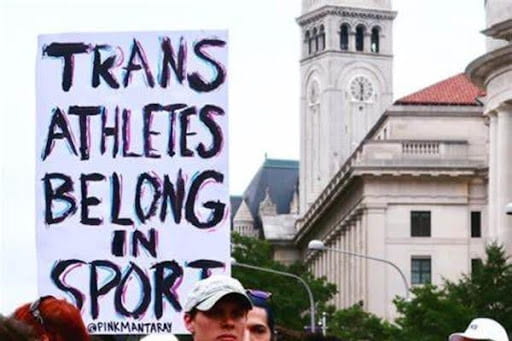By Khaled Itani | Staff Writer
The contentious debate surrounding the inclusion of transgender athletes in female sports has been long and full of controversy, delving into the complexities of fairness and inclusivity. From examining biological differences to navigating social and ethical considerations, it remains a challenge for the ISF (International Sports Federation) to properly navigate whether or not transgender individuals should be allowed to participate in women’s sports considering the clear genetic differences, or whether a separate sports category should be created for the transgender community.
One of the main controversies surrounding the inclusion of transgender athletes in women’s sports revolves around the physiological advantages that some transgender women may retain as a result of their male puberty. This includes factors such as muscle mass, bone density, and hemoglobin levels, which can affect athletic performance. A study performed showed that Post-Pubescent males have 15 times the amount of circulating testosterone as post-pubescent females. This is equivalent to a 10–12% performance advantage in running and swimming and a 20% advantage in jumping events, according to a 2018 Endocrine Review article by David Handelsman et al. Core biological differences exist between a transgender woman and a cisgender woman. A study carried out by Dr. Timothy Roberts and his colleagues found that transwomen who underwent hormone therapy for one year continued to outperform cisgender women. These findings underscore the importance of ongoing research in developing inclusive and equitable policies that uphold the integrity of women’s sports.
“Decisions are always difficult when they involve conflicting needs and rights between different groups, but we continue to take the view that we must maintain fairness for female athletes above all other considerations,” World Athletics president Sebastian Coe said in a statement after they released new regulations that transgender athletes need to be eligible to compete internationally in the female category. This sparked outrage among the community “We are beyond devastated to see World Athletics succumbing to political pressure instead of core principles of inclusion, fairness, and non-discrimination for transgender athletes and athletes with intersex variations,” said Hudson Taylor, founder and executive director of advocacy group Athlete Ally, showing his clear discontent with the decision.
Legal considerations surrounding transgender participation in women’s sports are multifaceted and often subject to complex interpretation and debate. One key aspect involves the evolving landscape of anti-discrimination laws and regulations at various levels of government. In some jurisdictions, there have been legal challenges and debates over whether policies that restrict or regulate transgender athletes’ participation due to their gender identity violate anti-discrimination laws, particularly those protecting against sex-based discrimination. This is seen in the case of Lia Thomas, who is the public face of transgender athletes today, as she began legal proceedings against World Aquatics, which is the swimming’s governing body. This was due to the World Aquatics vote to restrict transgender athletes from competing in elite women’s aquatics competitions according to the Court of Arbitration for Sport. In response to that, World Aquatics created an open category for transgender athletes at a World Cup event in Berlin for “all sex and gender identities”, this category aimed to shut down any claim that World Aquatics was being unfair and discriminatory against transgender women. However, Danne Diamond, a director of policy and programs for Athlete Ally says that “the ban is not a fair, proper, or reasonable balancing of rights” and later added that “it is grossly disproportionate and has the effect of excluding virtually all trans women athletes from international aquatics”.
Title IX of the 1972 federal Education Amendments, which prohibiting sex-based discrimination in any school or educational program receiving funding from the federal government, marks the beginning of the end of women’s sports as we know it. So the presence of transgender athletes in cisgender women’s sports is provocative, those who opposed their participation appealed to the principle of fair competition, with now more than 15 states in the process of passing legislation that prohibits transgender women from competing against cisgender women. Fairness in sports refers to equitable treatment of individuals based on their biological sex. It involves establishing rules and regulations that ensure a level playing field for male and female athletes, recognizing inherent physiological differences between the sexes.
In conclusion, the debate surrounding transgender participation in women’s sports highlights the complex interplay of legal, ethical, and philosophical considerations. Recent decisions by governing bodies have sparked controversy, underscoring the ongoing challenge of balancing inclusivity with maintaining fairness in competitive sports. Trans athletes belong in sports. How will governing bodies commit to upholding principles of equity for all athletes? While providing a proper guideline for transgender individuals to have the opportunity to participate in sports?
References
Tucker, D. C., Emma. (2024, January 27). Transgender swimmer Lia Thomas begins legal case against swimming’s world governing body. CNN. https://edition.cnn.com/2024/01/26/us/lia-thomas-world-aquatics-transgender-athletes-swimming/index.html
U.S. Department of Education. (2021). Title IX and Sex Discrimination. Title IX and Sex Discrimination. http://www.ed.gov/about/offices/list/ocr/docs/tix_dis.html
Morse, B. (2023, March 23). World Athletics tightens rules on transgender women athletes. CNN. https://edition.cnn.com/2023/03/23/sport/world-athletics-transgender-ruling-spt-intl/index.html
Handelsman, D. J., Hirschberg, A. L., & Bermon, S. (2018). Circulating Testosterone as the Hormonal Basis of Sex Differences in Athletic Performance. Endocrine reviews, 39(5), 803–829. https://doi.org/10.1210/er.2018-00020

